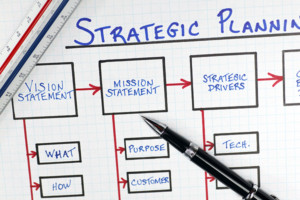How a properly plan and utilized workshop can move your reliability program forward.

Business Strategic Planning Framework Diagram
Many organizations often struggle to move plans forward. This may be due to the decision-making process and the people involved in the process. Often times the various decision makers are scattered across the company and may be distracted by issues in the plant. In other circumstances, the organization may know what the end goal is, but may not be aware of how to get there.
By properly developing and delivering a workshop with an experienced facilitator, organizations may be able to condenses weeks (or even months) of educating, and decision making into a few days. How can this be? By structuring a workshop in a methodical way, a facilitator can educate all key stakeholders on how to achieve the goal, and facilitate decision-making and planning process. After just three to four days, a finalized plan is developed and approved by all key decision makers.
So how is it possible to condense all this work into a three or four-day workshop? Utilize the Plan, Do, Check, Act methodology. If the organization does not have the right competencies, utilize an experienced facilitator to prepare and deliver the workshop. Regardless of who is developing and delivering the workshop, the methodology is the same.
Plan
Planning the workshop requires a systematic approach. The workshop may start off by reviewing the current process or data and comparing to best practice. While comparing to best practice, utilize the opportunity to highlight both internal and external best practice. In this aspect, you are educating everyone in the room.
Once everyone understands the gaps and potential returns of the improvement, the workshop can change pace a bit and work to make decisions around the next steps, potential solutions, etc. The facilitator will be hard at work getting everyone to come to a consensus. This is where experience comes in for both designing the workshop and delivering it. Once the solution or approach is determined, the workshop should be designed to produce a plan. The plan doesn’t have to be extremely detailed, but major milestones, due dates, and owners established.
The critical factor in planning the workshop and the ultimate success of the workshop is to get senior level support and the right people in the room for it. The workshop should be made up of key stakeholders and decision makers. Only when decision makers are in the room, will the team be able to move ahead quickly?
Lastly, to minimize distractions, try to plan the workshop off-site. This will prevent people from being pulled into the daily grind.
Do
When the workshop does kick off, be sure to establish ground rules. Let the group establish the ground rules. It will encourage participation early in the workshop. One of my favorite parts of the ground rules is to determine the penalty for those coming back late from break or playing on their phone… my favorite is singing a song for 30 seconds. This makes sure people get back on time. By being on time, the agenda can be followed and adhered to. This will ensure that all expectations and outcomes are achieved.
It is during the workshop that the facilitator records the decisions, take names, and due dates for all actions. With this information, a summary or findings document will be created as the workshop progresses. Be sure to review the document each morning for the previous day. This will refresh everyone’s mind on what was covered and act as a form of review to validate the information was recorded correctly.
Check
At the end of the workshop, stop and verify that all major outcomes & expectations have been achieved. This may entail review the findings document in detail, developing a more detailed plan. There should not be any major actions to clarify information or get a decision. If there are these types of actions, the right people were not in the room. Once finalized, send out the summary or findings document to everyone in the workshop. The organization now has an approved plan to move forward.
Act
The purpose of the workshop is to generate an agreed upon, approved plan, supported by senior decision makers. The entire workshop would be a waste if the plan were not executed. Therefore begin to execute the immediate activities;
- Gather quotes
- Assign resources
- Issue purchase orders
- Start working
This approach has been successfully utilized in defining Roles & Responsibilities, Spare Parts Data Cleansing, Planning & Scheduling Improvements, and Equipment Strategy development. This approach is versatile when properly planned and executed. If you are interested in utilizing this approach, contact Eruditio, LLC for a one-hour free consultation.
Remember, to find success, you must first solve the problem, then achieve the implementation of the solution, and finally sustain winning results.
I’m James Kovacevic
Eruditio, LLC
Where Education Meets Application
Follow @EruditioLLC



